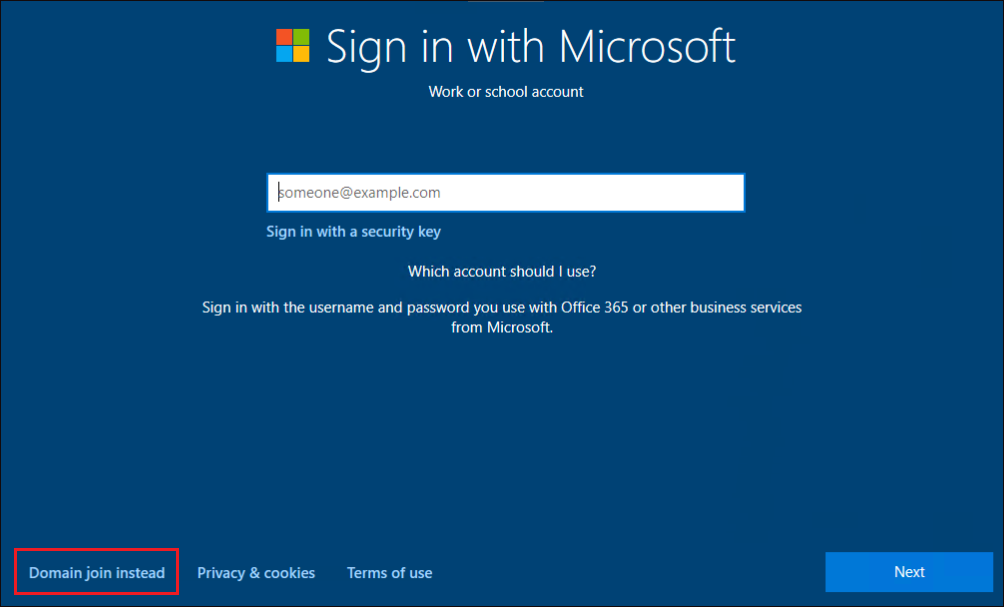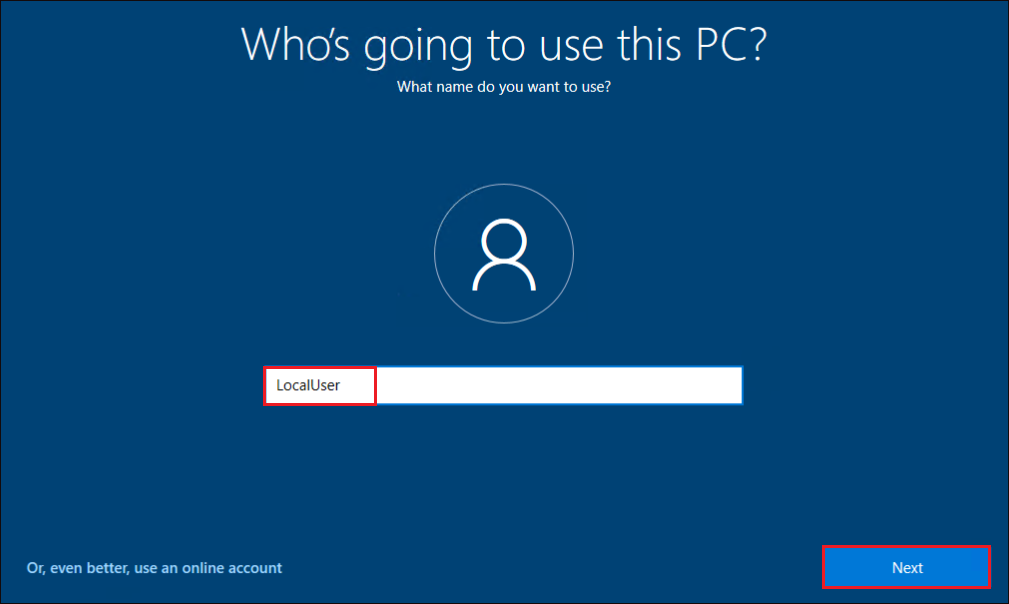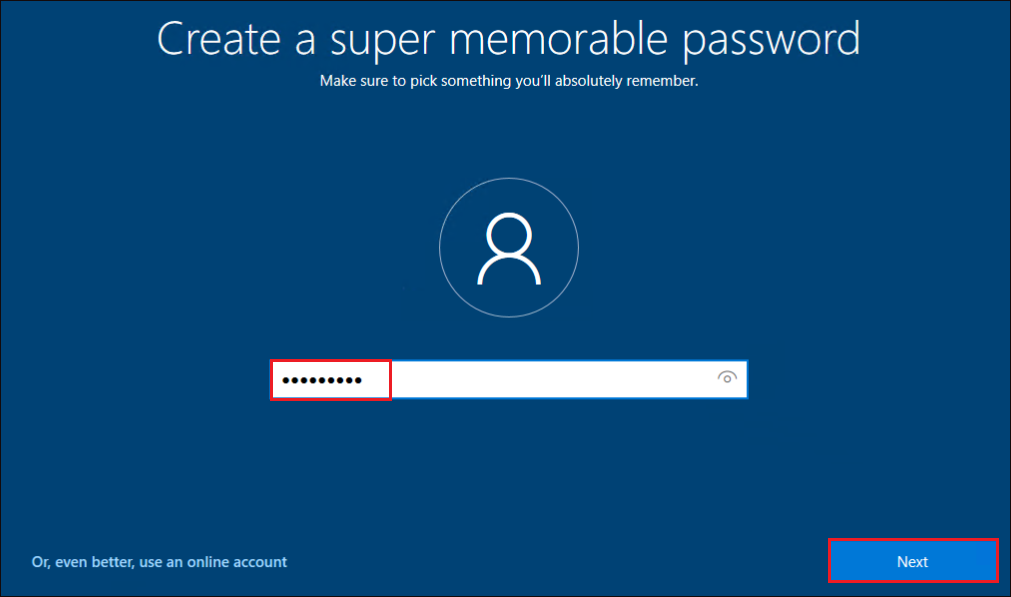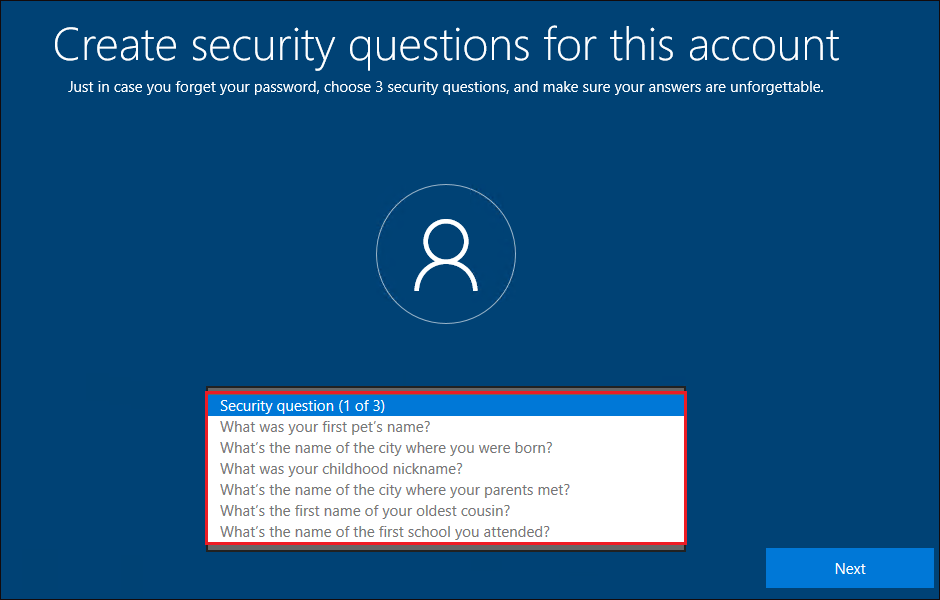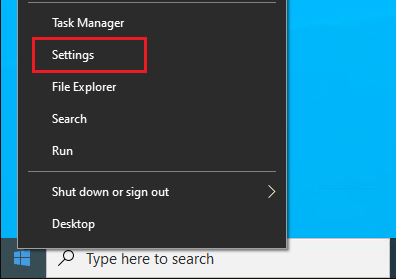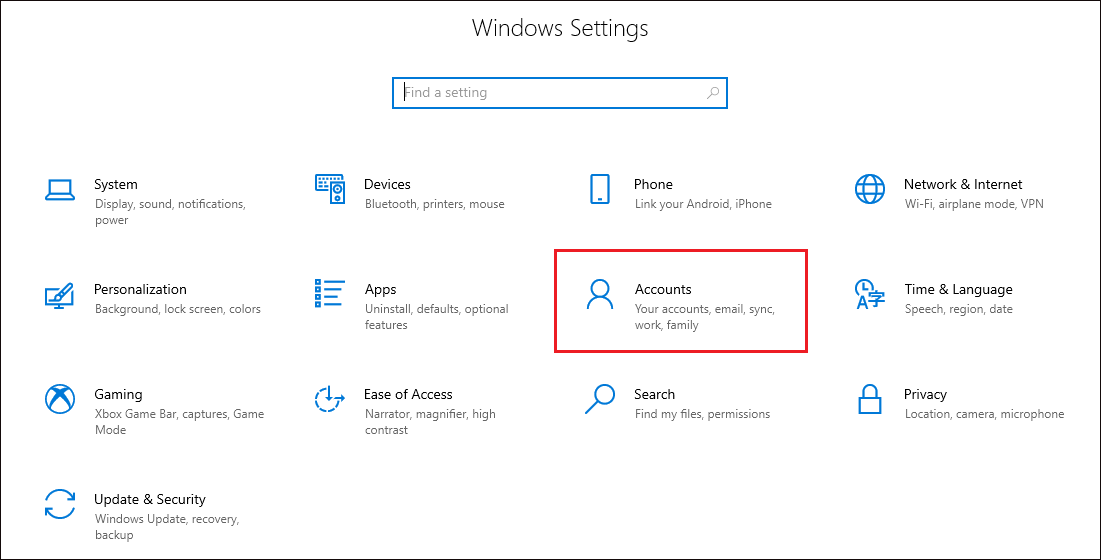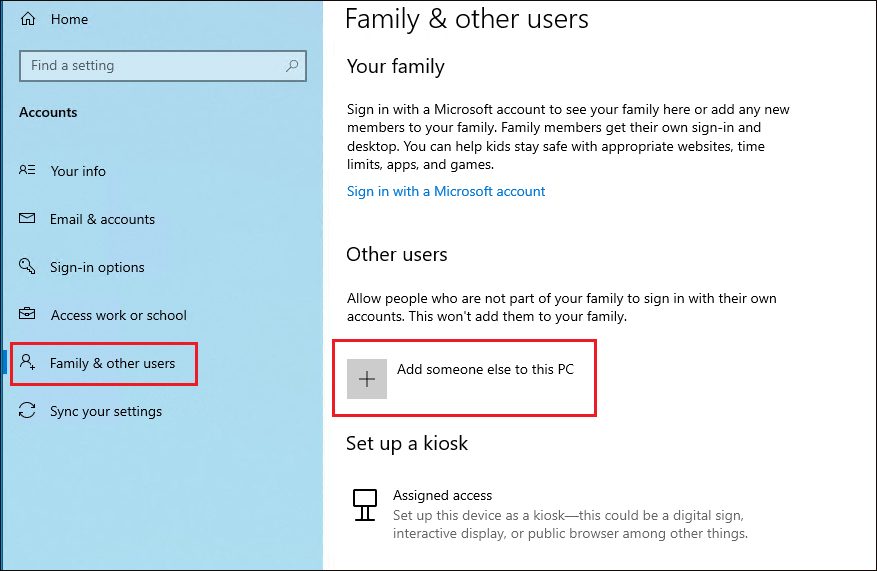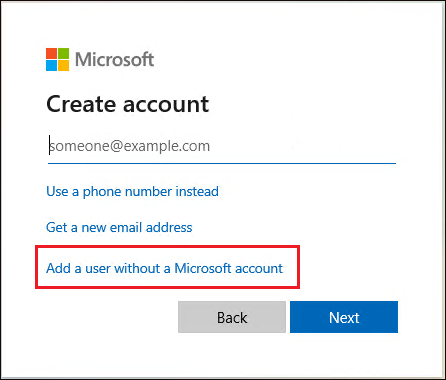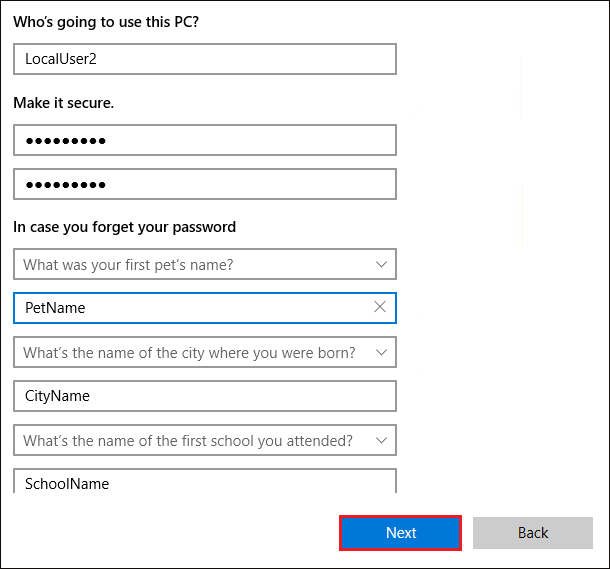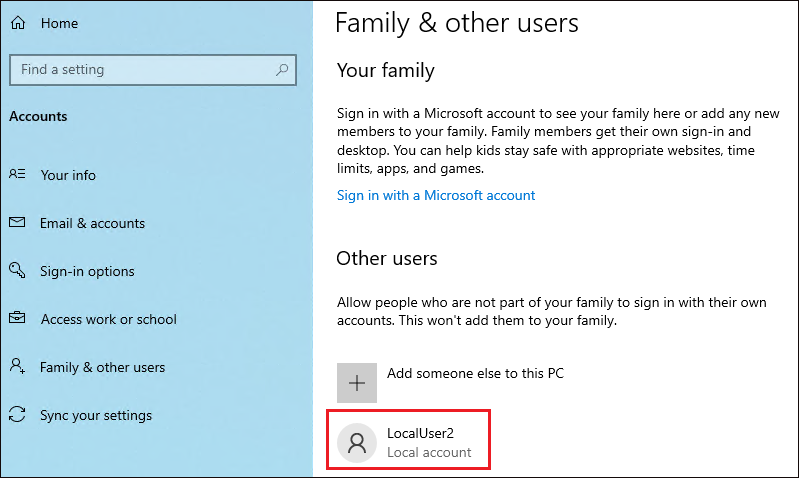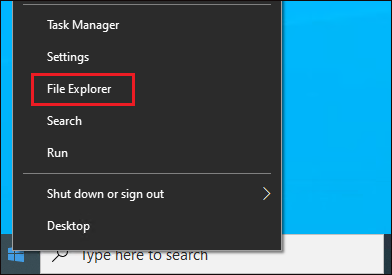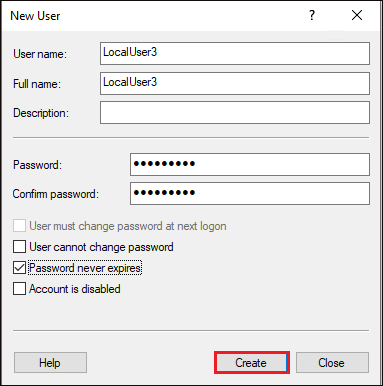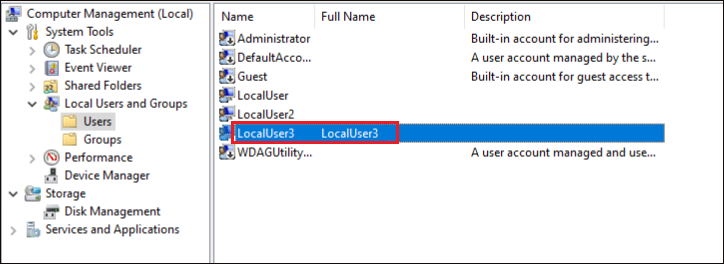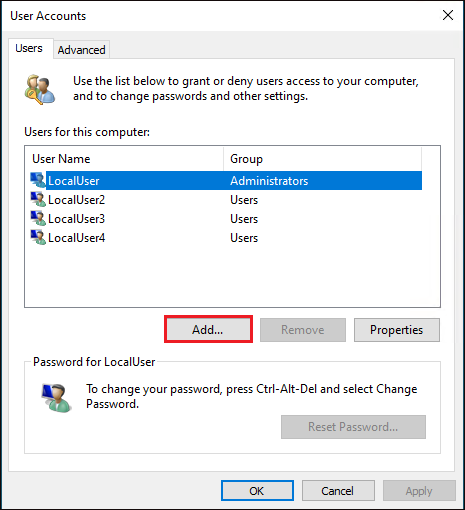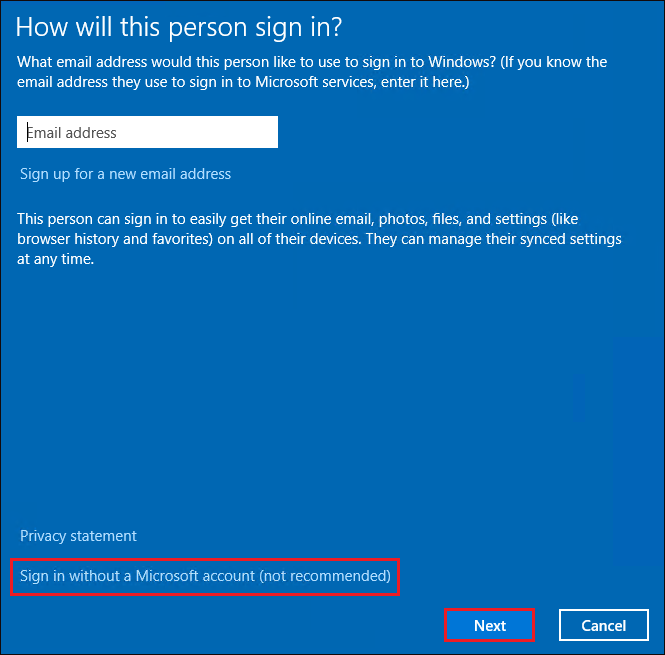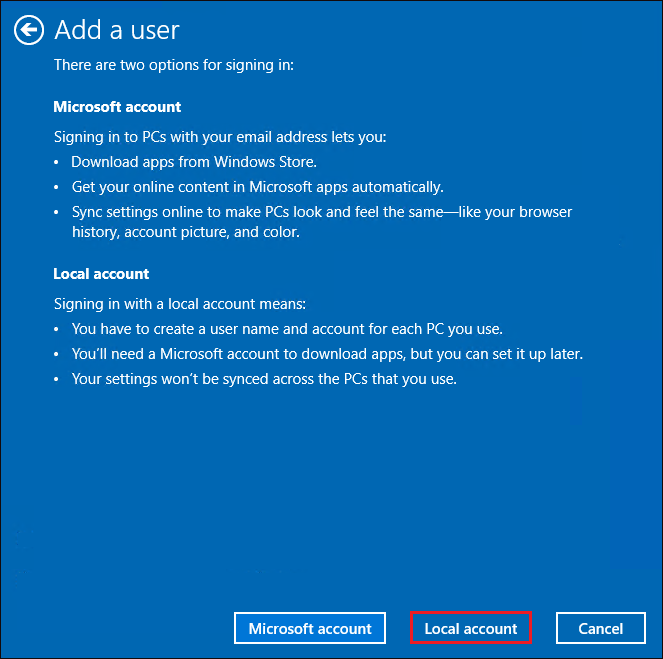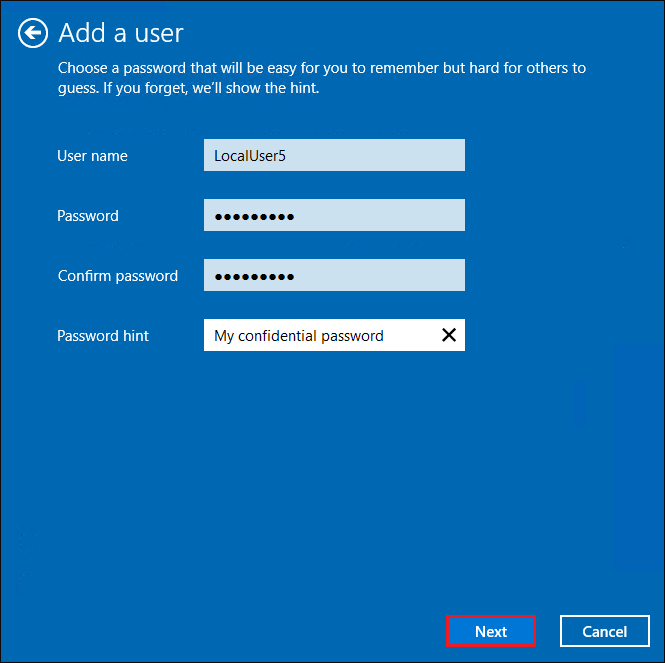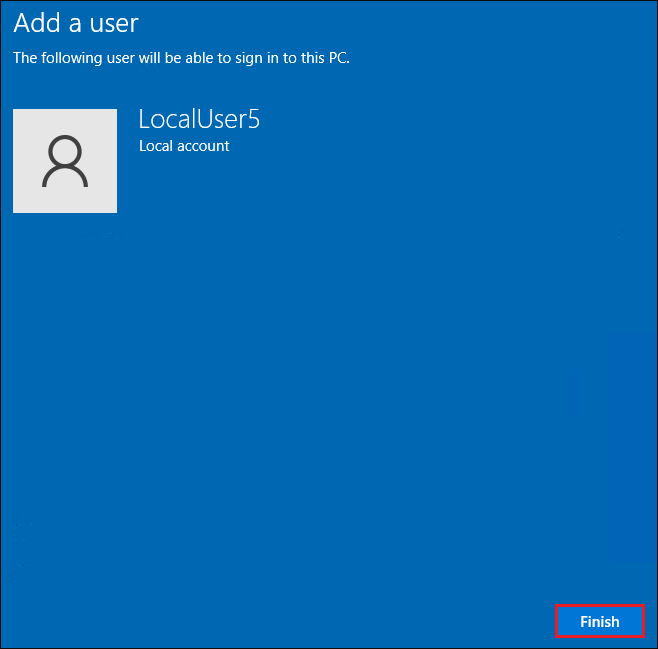You can create a local user account (an offline account) for anyone who will frequently use your PC. The best option in most cases, though, is for everyone who uses your PC to have a Microsoft account. With a Microsoft account, you can access your apps, files, and Microsoft services across your devices.
If needed, the local user account can have administrator permissions; however, it’s better to just create a local user account whenever possible.
Caution: A user with an administrator account can access anything on the system, and any malware they encounter can use the administrator permissions to potentially infect or damage any files on the system. Only grant that level of access when absolutely necessary and to people you trust.
As you create an account, remember that choosing a password and keeping it safe are essential steps. Because we don’t know your password, if you forget it or lose it, we can’t recover it for you.
Create a local user account
- Select Start >Settings >Accounts and then select Family & other users. (In some versions of Windows you’ll see Other users.)
- Next to Add other user, select Add account.
- Select I don’t have this person’s sign-in information, and on the next page, select Add a user without a Microsoft account.
- Enter a user name, password, or password hint—or choose security questions—and then select Next.
Open Settings and create another account
Change a local user account to an administrator account
- Select Start >Settings >Accounts .
- Under Family & other users, select the account owner name (you should see «Local account» below the name), then select Change account type. Note: If you choose an account that shows an email address or doesn’t say «Local account», then you’re giving administrator permissions to a Microsoft account, not a local account.
- Under Account type, select Administrator, and then select OK.
- Sign in with the new administrator account.
If you’re using Windows 10, version 1803 and later, you can add security questions as you’ll see in step 4 under Create a local user account. With answers to your security questions, you can reset your Windows 10 local account password. Not sure which version you have? You can check your version.
Create a local user account
- Select Start >Settings >Accounts and then select Family & other users. (In some versions of Windows you’ll see Other users.)
- Select Add someone else to this PC.
- Select I don’t have this person’s sign-in information, and on the next page, select Add a user without a Microsoft account.
- Enter a user name, password, or password hint—or choose security questions—and then select Next.
Open Settings and create another account
Change a local user account to an administrator account
- Select Start >Settings >Accounts .
- Under Family & other users, select the account owner name (you should see «Local Account» below the name), then select Change account type. Note: If you choose an account that shows an email address or doesn’t say «Local account», then you’re giving administrator permissions to a Microsoft account, not a local account.
- Under Account type, select Administrator, and then select OK.
- Sign in with the new administrator account.
Related topics
Microsoft account help
How to reset your Microsoft account password
Get help with Windows activation errors
Need more help?
This article will show you how to create a new local user account on your Windows 10 computer. A local user account is different than a Microsoft account because with a local account, you don’t need a Microsoft email address. Follow Method 1 if you are signed in to an Administrator account; follow Method 2 if you are signed in to a Standard account.
200 characters left
Include your email address to get a message when this question is answered.
To change the account type to administrator, click the name of the account under the «Other people» header, click Change account type , click Administrator from the dropdown, and click OK .
It is recommended to create a password to prevent your new account from unauthorized access, but you don’t have to.
If you are creating a password, make sure you write it down and keep it in a safe place.
Thanks for submitting a tip for review!
If you don’t create a password, an unauthorized person can access your account just by clicking «Sign in».
If you forget the password for a local account, there’s no way to recover the password.
About This Article
Article Summary X
1. Open Settings (Start > Settings).
2. Click Accounts.
3. Click Family & other people to the left.
4. Click + Add someone else to this PC.
5. Click I don’t have this person’s sign-in information.
6. Click Add a user without a Microsoft account.
7. Enter all the details and click Next. A password is optional.
Did this summary help you?
Thanks to all authors for creating a page that has been read 28,991 times.
Is this article up to date?
В этой инструкции для начинающих о том, как создать нового пользователя Windows 10 несколькими способами, как сделать его администратором или наоборот, создать ограниченную учетную запись пользователя компьютера или ноутбука. Также может пригодиться: Как удалить пользователя Windows 10.
В Windows 10 присутствуют два типа учетных записей — учетные записи Майкрософт (требующие адреса электронной почты и синхронизирующие параметры онлайн) и локальные учетные записи пользователей, не отличающиеся от тех, которые могут быть вам привычны по ранним версиям Windows. При этом одну учетную запись всегда можно «превратить» в другую (например, Как удалить учетную запись Майкрософт). В статье будут рассмотрено создание пользователей с обоими типами учетных записей. Также может быть полезным: Как сделать пользователя администратором в Windows 10.
- Создание нового пользователя в Параметрах Windows 10
- Как создать пользователя в командной строке
- Локальные пользователи и группы Windows 10
- Добавление пользователя в control userpasswords2
- Видео инструкция
Создание пользователя в параметрах Windows 10
Основной способ создания нового пользователя в Windows 10 — использование пункта «Учетные записи» нового интерфейса настроек, доступного в «Пуск» — «Параметры». В указанном пункте настроек откройте раздел «Семья и другие пользователи».
- В разделе «Ваша семья» вы сможете (при условии, что используете учетную запись Майкрософт) создать учетные записи для членов семьи (также синхронизируемые с Майкрософт), подробнее о таких пользователях я писал в инструкции Родительский контроль Windows 10.
- Ниже, в разделе «Другие пользователи» можно добавить «простого» нового пользователя или администратора, учетная запись которого не будет контролироваться и являться «членом семьи», можно использовать как учетные записи Майкрософт, так и локальные учетные записи. Этот вариант будет рассматриваться далее.
Для создания нового пользователя, не входящего в семью и без возможностей родительского контроля, выполните следующие шаги:
- В разделе «Другие пользователи» нажмите «Добавить пользователя для этого компьютера».
- В следующем окне вам будет предложено указать адрес электронной почты или номер телефона — введите их, при условии, что вы хотите добавить пользователя с уже существующей учетной записью Майкрософт.
- Если вы собираетесь создавать локальную учетную запись (или даже учетную запись Майкрософт, но пока не зарегистрировали e-mail для нее), нажмите «У меня нет данных для входа этого человека» внизу окна.
- В следующем окне будет предложено создать учетную запись Майкрософт. Вы можете заполнить все поля для создания пользователя с такой учетной записью или нажать «Добавить пользователя без учетной записи Майкрософт» внизу.
- В следующем окне останется ввести имя пользователя, пароль (если требуется пользователь без пароля, просто не вводите ничего в соответствующие поля), подсказку для пароля и указать вопросы для восстановления пароля, на случай, если он будет забыт. Этого достаточно, чтобы новый пользователь Windows 10 появился в системе и под его учетной записью был возможен вход.
По умолчанию, новый пользователь имеет права «обычного пользователя». Если нужно сделать его администратором компьютера, выполните следующие шаги (при этом, вы для этого также должны быть администратором):
- Зайдите в Параметры — Учетные записи — Семья и другие пользователи.
- В разделе «Другие пользователи» нажмите по пользователю, которого нужно сделать администратором и кнопку «Изменить тип учетной записи».
- В списке выберите «Администратор» и нажмите Ок.
Войти под новым пользователем можно, нажав по имени текущего пользователя вверху меню пуск или с экрана блокировки, предварительно выйдя из текущей учетной записи.
Как создать нового пользователя в командной строке
Для того, чтобы создать пользователя с помощью командной строки Windows 10, запустите ее от имени администратора (например, через меню правого клика по кнопке «Пуск»), после чего введите команду (если имя пользователя содержит пробелы, используйте кавычки, пароль брать в кавычки не нужно):
net user имя_пользователя пароль /add
И нажмите Enter.
После успешного выполнения команды, в системе появится новый пользователь. Также вы можете сделать его администратором, используя следующую команду (если команда не сработала, а у вас не лицензия Windows 10, попробуйте вместо Администраторы писать administrators):
net localgroup Администраторы имя_пользователя /add
Вновь созданный таким образом пользователь будет иметь локальную учетную запись на компьютере.
Создание пользователя в «Локальные пользователи и группы» Windows 10
И еще один способ создания локальной учетной записи с помощью элемента управления «Локальные пользователи и группы»:
- Нажмите клавиши Win+R, введите lusrmgr.msc в окно «Выполнить» и нажмите Enter.
- Выберите «Пользователи», а затем в списке пользователей кликните правой кнопкой мыши и нажмите «Новый пользователь».
- Задайте параметры для нового пользователя.
Чтобы сделать созданного пользователя администратором, кликните по его имени правой кнопкой мыши, выберите пункт «Свойства». Затем, на вкладке «Членство в группах» нажмите кнопку «Добавить», наберите «Администраторы» и нажмите «Ок».
Готово, теперь выбранный пользователь Windows 10 будет иметь права администратора.
Добавление учетной записи в control userpasswords2
И еще один очень простой способ добавления новой учетной записи пользователя Windows 10:
- Нажмаем клавиши Win+R, вводим control userpasswords2
- В списке пользователей нажимаем кнопку добавления нового пользователя
- Дальнейшее добавление нового пользователя (доступны как учетная запись Майкрософт, так и локальная учетная запись) будет выглядеть тем же самым образом, что и в первом из описанных способов.
Видео инструкция
Если остались какие-либо вопросы или что-то не получается так просто, как это описано в инструкции — пишите, постараюсь помочь.
Учетные записи позволяют нескольким людям довольно комфортно пользоваться ресурсами одного ПК, так как предоставляют возможность разделить данные и файлы юзеров. Процесс создания таких записей довольно прост и тривиален, поэтому если у Вас возникла такая потребность, просто воспользуйтесь одним из методов для добавления локальных аккаунтов.
Далее более подробно рассмотрим, как в операционной системе Виндовс 10 можно создавать локальные учетки несколькими способами.
Важно упомянуть, что для создания и удаления юзеров, независимо от выбранного Вами метода, необходимо зайти в систему под именем администратора. Это обязательное условие.
Способ 1: Параметры
- Нажмите кнопку «Пуск» и щелкните по иконке в виде шестерни («Параметры»).
- Зайдите в «Учетные записи».
Способ 2: Панель управления
Способ добавления локального аккаунта, который частично повторяет предыдущий.
- Откройте «Панель управления». Это можно сделать, выполнив правый клик по меню «Пуск», и выбрав необходимый пункт, или с помощью комбинации клавиш «Win+X», вызывающей аналогичное меню.
- Нажмите «Учетные записи пользователей».
Способ 3: Командная строка
Намного быстрее создать аккаунт можно через командную строку (cmd). Для этого нужно всего лишь выполнить такие действия.
- Запустите командную строку («Пуск-> Командная строка»).
- Далее наберите следующую строку (команду) net user «Имя пользователя» /add где вместо имени нужно ввести логин для будущего юзера, и нажмите кнопку «Enter».
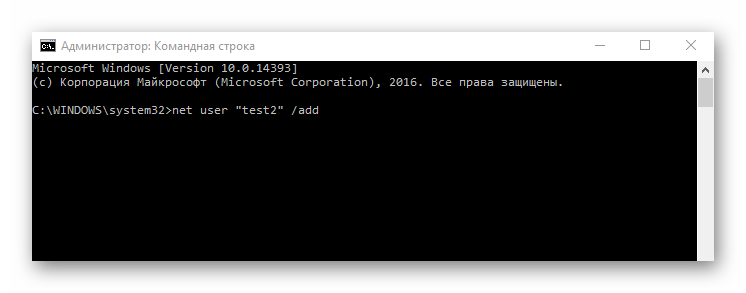
Способ 4: Окно команд
Еще один способ добавить учетные записи. Аналогично cmd, этот метод позволяет быстро выполнить процедуру создания нового аккаунта.
- Нажмите «Win+R» или откройте через меню «Пуск» окно «Выполнить» .
- Наберите строку control userpasswords2 щелкните «ОК».
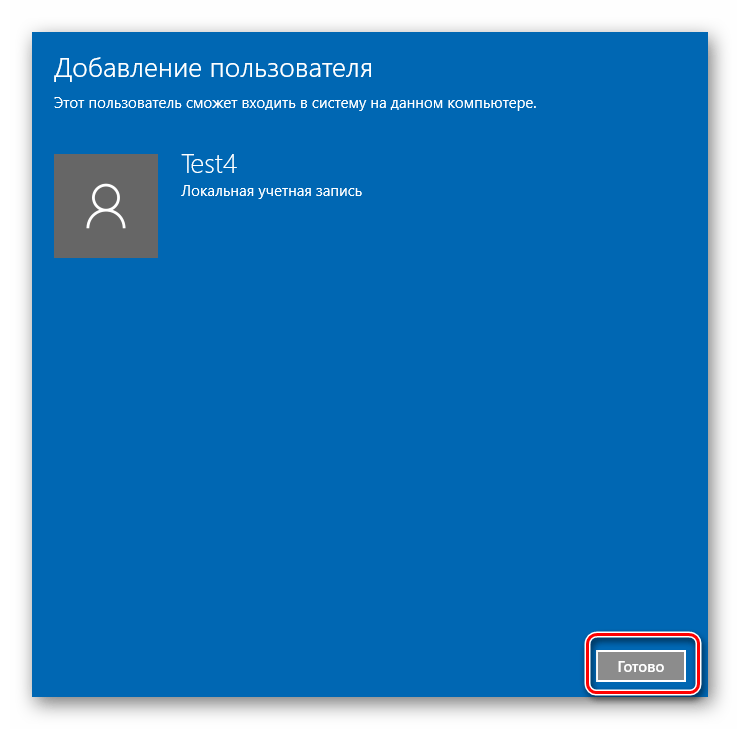
Также в окне команд можно ввести строку lusrmgr.msc , результатом выполнения которой будет открытие объекта «Локальные пользователи и группы». С его помощью также можно добавить учетку.
-
Щелкните по элементу «Пользователи» правой кнопкой мыши и в контекстом меню выберите пункт «Новый пользователь…»
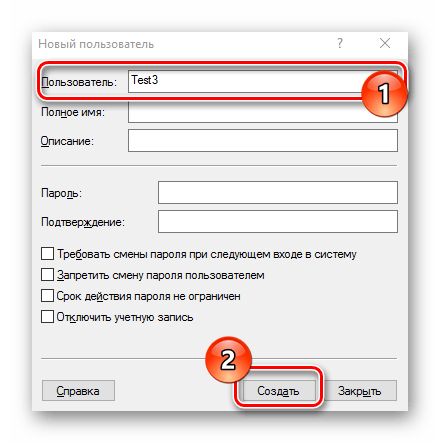
Все эти методы позволяют легко добавить новые учетки на персональный компьютер и не требуют особых навыков, что делает их доступными даже для малоопытных юзеров.
Еще статьи по данной теме:
Помогла ли Вам статья?
One of the Windows 10 capabilities, is to add a Microsoft online account on your PC (or device) in order to use all the Microsoft services (Email, Modern Apps, Xbox games, Skype, OneDrive, etc.) with one account. Additionally, if you setup a Microsoft account in Windows 10, you ‘ll have the ability to sign-in from any other Windows 10 device (which connected to Internet) and have all your apps, settings and passwords synchronized on the new device.
If you ‘are not interested to use the Windows Store, or if you don’t want to use the advantages offered by using a Microsoft online account, then is better to setup a Local Account in Windows 10. At my opinion, a Local account is always more secure than a Microsoft online account and always works, regardless of Internet connectivity.
This tutorial shows tree (3) different methods to add a new user account in Windows 10 and Windows 8.1 in case you need it. (e.g. if you want to share your computer or files with others).
How to Create a New User in Windows 10, 8.1.
Method 1. Create New Account from Settings options.
Method 2. Add New Account by using the ‘User Accounts’ utility in Windows 10/8.
Method 3. Create A New User using Command Prompt in Windows 10/8.
Method 1. How to Create New Account from Settings in Windows 10.
1. Sign-in to Windows with an Administrator account.
2. Open Settings and then click Accounts.
3. Choose Family & other users on the left and then click Add someone else to this PC.
4. At the next screen:
A. if you want to add a new Microsoft Account on the PC, type the new person’s email address and click Next.
B. If you want to add a new Local account (like in this example), click I don’t have this person’s sign-in information.
5. Then click Add a user without a Microsoft account.
6. At the next screen type a username and a password for the new account. Then choose and answer the given security questions* in case you forgot the password and when done click Next.
* Note: If you don’t like to answer all these «stupid» security questions, then go proceed to add the new user, by using the method-1 or the method-2 below.
7. At this point, you have ended with the creation of a new Standard user on Windows 10. But, ff you want to give administrative privileges to the new user:
a. Select the user and click Change account type.
b. At the next screen change the account type to ‘Administrator’ and click OK.
Method 2. Add New Account by using the ‘User Accounts’ utility in Windows 10/8.
One of my favorite methods to add (or remove) users (in all Windows versions), is by using the ‘User Accounts’ utility, which gives all the needed options to easy manage Windows accounts. (Add/Remove Users, Specify User Privileges or to Change User Password).
1. Sign-in to Windows with an Administrator account.
2. Press Windows + R keys to open the run command box.
3. In the «Open» box, type: control userpasswords2 & click OK.
4. In Users tab, click the Add button to add the account, that you want to have access to your files.
5. Choose Sign in without a Microsoft Account in order to create a local account, of fill the user’s email address if you want to create a Microsoft Account
6. Then choose Local Account.
7. Fill the required fields (username, password & password hint) and click Next.
8. At the last screen click Finish.
9. Finally, if you want to set the new user as Administrator on the computer:
a. Highlight the user and select Properties
b. Then at Group Membership tab, place the bullet to Administrator and click OK.
Method 3. How to Create or Delete a User with Command Prompt in Windows 10/8/7 OS.
The most easiest method to add or remove users on all Windows versions, is by using the command prompt.
To add a new account from command prompt:
1. Open Command Prompt As Administrator.
2. At command prompt type the following command and press Enter:
* Note: At the above command change the fields « username » & « password «, according your choice.
- net user John Pas123 /add
3. Finally if you want to add the new user to the Administrators group, give this command:
- net localgroup administrators username /add
- net localgroup administrators John /add
To delete a user from command prompt:
1. Open Command Prompt As Administrator.
2. At command prompt type the following command and press Enter:
e.g. if you want to delete the user «John», type:
- net user John /delete
That’s all folks! Did it work for you?
Please leave a comment in the comment section below or even better: like and share this blog post in the social networks to help spread the word about this problem.
If this article was useful for you, please consider supporting us by making a donation. Even $1 can a make a huge difference for us.
Did you know you can add a Windows 10 local account and log in to the PC without using a Microsoft account or an email address? If you’re looking for a way to do it, then this tutorial is for you.
With Windows 10, you have the option of creating a local user or using your existing Microsoft account to log in to the PC. Let’s look at different options in creating a local user account.
In this tutorial, you will learn all the different ways to create a local user account on Windows 10. Let’s jump right in.
Prerequisites
- Windows 10 PC with administrator account. This tutorial will use Windows 10 21H1 Enterprise version.
Creating Windows 10 Local Account User While Installing Windows 10
One of the first ways you’ll find to create a local user account in Windows 10 is via Windows Setup. Once installation is complete, you’ll be asked to sign in with a Microsoft account. Even though it seems you must use a Microsoft account, you can create a local account instead. The option to do so is just hidden.
- When prompted to login with a Microsoft account, click Domain join instead option in Sign in with Microsoft work or school account step.
Displaying Domain Join option
2. Enter a username for the local user account and click Next.
Displaying user name column
3. Type a password and confirm the password in the next step. Click Next.
Displaying password column
4. Provide answers to the security questions and click Next.
When you forget your login password, you will be prompted to enter answers for all these three questions to reset your password.
Answering Security Questions
5. Accept the defaults through the next few steps. Once complete, you will be logged in with your local account.
Creating a Local User Account From the Settings App
Now that you’ve learned how to create a local user account at the time of OS installation, let’s now dig into creating a local user account post-installation.
1. Access the Windows settings by right-clicking on the start menu, then select Settings.
Settings option on start menu, right click
2. Get access to Account settings by clicking on Accounts in the Windows Settings box.
Selecting Accounts option
3. To add a local account, click on Family & other users option at the left panel. Click Add someone else to this PC option to the right and Microsoft’s sign-in screen will appear.
Selecting Add someone else to this PC option
4. In the sign-in window below, an email address is not needed. Since you’re creating a local account, click on I don’t have this person’s sign-in information and click Next.
Microsoft sign-in screen
5. Next click on Add a user without a Microsoft account option.
Displaying Add a user without a Microsoft account option
6. Enter a username and password. The moment you start typing, password security questions will be displayed automatically. Once they do, select each security question and provide your answers and click Next when complete.
Filling the local user account details
7. Finally, log off from your PC and log in with the new user account!
windows 10 Local account user account creation complete
Creating a Local User Account with Computer Management
Up to this point, you’ve seen how to create a local user account in Windows 10 post-installation and via the Settings app. Let’s continue on the journey and now dig into creating a local user account via the Computer Management console.
1. Right-click on start menu, and click File Explorer option.
File Explorer option on start menu, right click
2. Right-click on This PC and click manage. This will open computer management console.
Displaying manage option
Need another way of opening the computer management console? Open run dialog box and enter compmgmt.msc. This will open computer management console.
3. In the Computer Management console, expand Local Users and Groups tab. Then right-click on the Users node and click New User to create an account under Users account type.
Creating New user…
Optionally open the Local Users and Groups console but running lusrmgr.msc.
4. In the new user dialog box, provide the User name, an optional Full name, and Password. When complete, click Create and then Close.
Filling the local user details
You’ll now notice that the local user account is added under the Users account type folder, in the Local Users and Groups section, as shown below. Now you have an active local account that is just like a Microsoft account in in Windows.
Verifying local user account creation in computer management console
Creating Local User Account with the Advanced User Accounts Control Panel
To finish off this tutorial’s whirlwind tour of creating local Windows 10 user accounts, let’s go through creating a local user account with the Advanced User Accounts Control Panel, sometimes referred to as netplwiz.
1. Click on the Start menu, type netplwiz, and run it.
2. In the User Accounts console, click Add you’ll be taken to the Microsoft account sign-in page.
netplwiz console
3. On the Microsoft account sign-in page, click on Sign in without a Microsoft account (not recommended) option and click Next.
Displaying Sign in without a Microsoft account (not recommended) option
4. On the Add a user page, click the Local account option.
Displaying Local account option
5. Provide a User name, Password and a Password hint for use when resetting the password.
Filling the local user details
6. Click Finish on the final confirmation page.
Local user account creation finish page
When complete, you’ll then see a new user account displayed in the User Accounts dialog box shown below.
Local user account creation confirmation.
Creating a Local User Account with the Net User Command
If creating a Windows 10 local user account via the GUI isn’t your thing, or you’re working on some automation scripts, the command line is your friend. Let’s now jump into creating local user accounts via cmd.exe.
Open a command prompt as administrator and run the below command. This command creates a new local user ( /add ) called LocalUser4 with a password of MyPassword!
This command will not enable any of the options like user must change password at next logon, user cannot change password, password never expires and account is disabled.
net user LocalUser4 MyPassword! /addnet user command output
Creating a Local User Account with PowerShell
Continuing on with the list of ways to create a local Windows 10 user account, next up is PowerShell!
Open PowerShell console as administrator.
Next, run the New-LocalUser cmdlet, as shown below.
The New-LocalUser cmdlet has a Password parameter but you cannot specify a simple string. To pass a password to the Password parameter, you must first convert your password into a secure string or encrypted string using the ConvertTo-SecureString cmdlet.
The below command first encrypts the password of MyComplexPassword! . Then using the $password variable sets the password for a user account called LocalUser6 .
$password = ConvertTo-SecureString -String MyComplexPassword! -AsPlainText -Force New-LocalUser -Name LocalUser6 -FullName LocalUser6 -Password $passwordNew-LocalUser cmdlet output
The New-LocalUser cmdlet also supports other parameters like PasswordNeverExpires or AccountNeverExpires .
Conclusion
You’ve seen a lot of different ways to create Windows 10 local accounts. Although the GUI options have more steps than the command-line, some prefer the graphical interface walking you through the steps vs. the command line options when automating the process, perhaps.
With what you’ve learned in this tutorial, which option would you choose to create user accounts, GUI way or command line? Let us know in the comments.
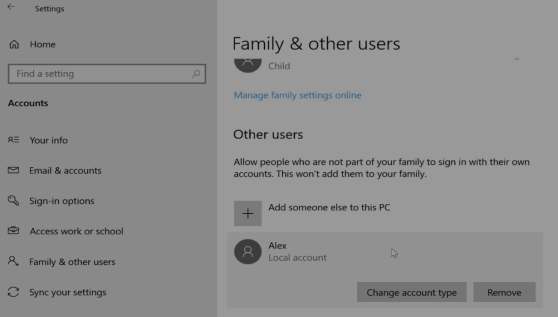











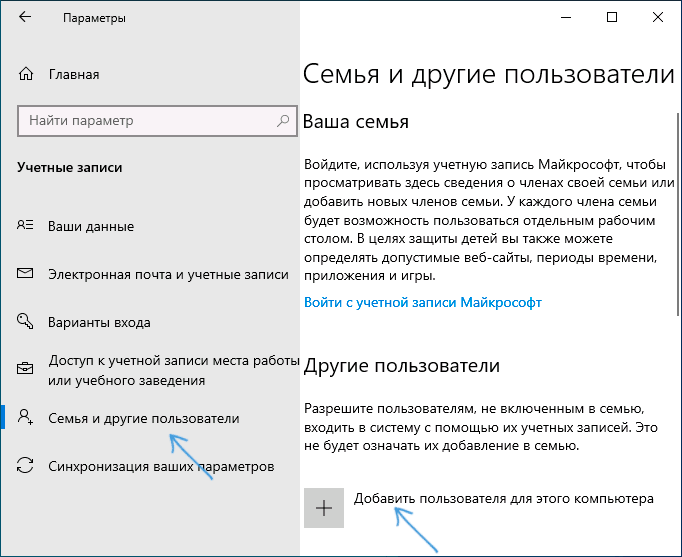
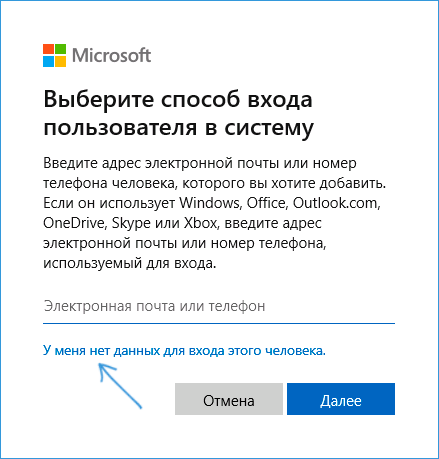




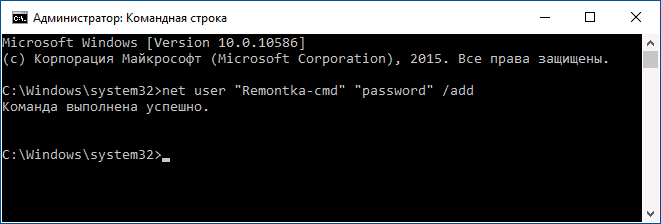


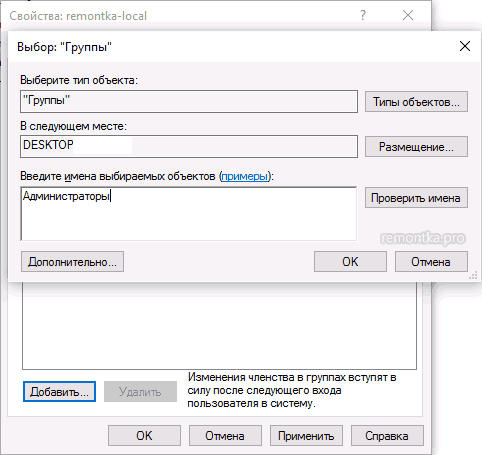

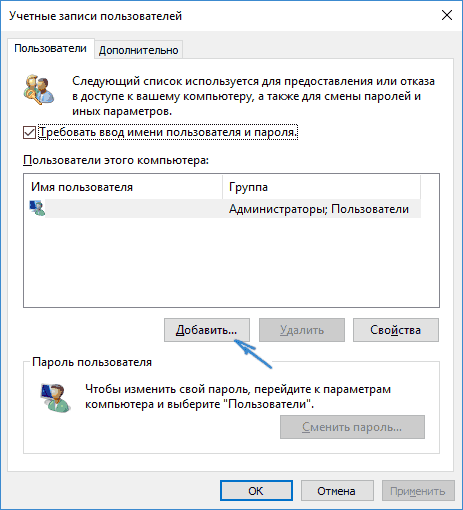

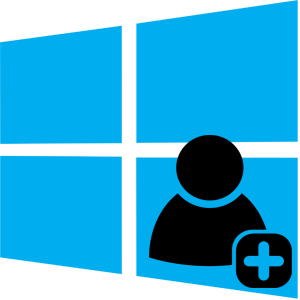
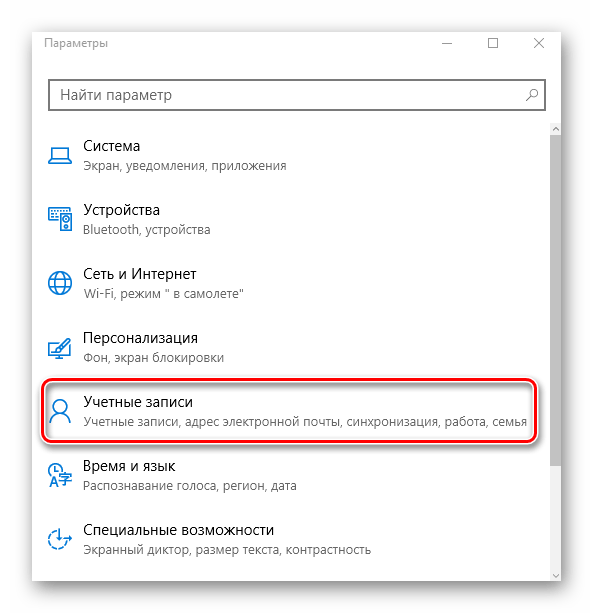

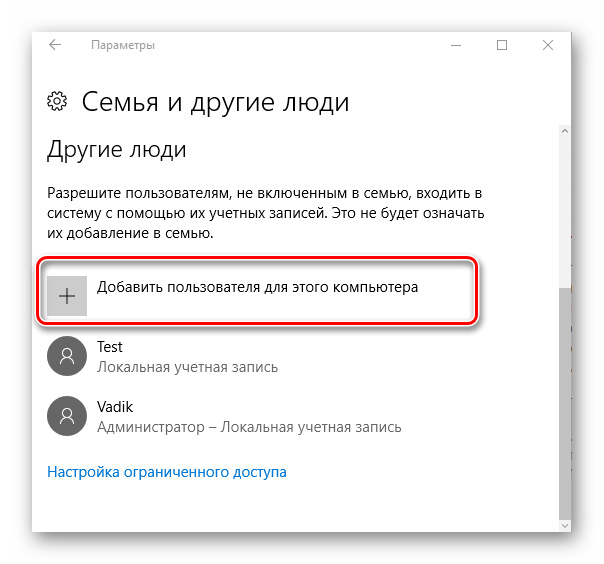
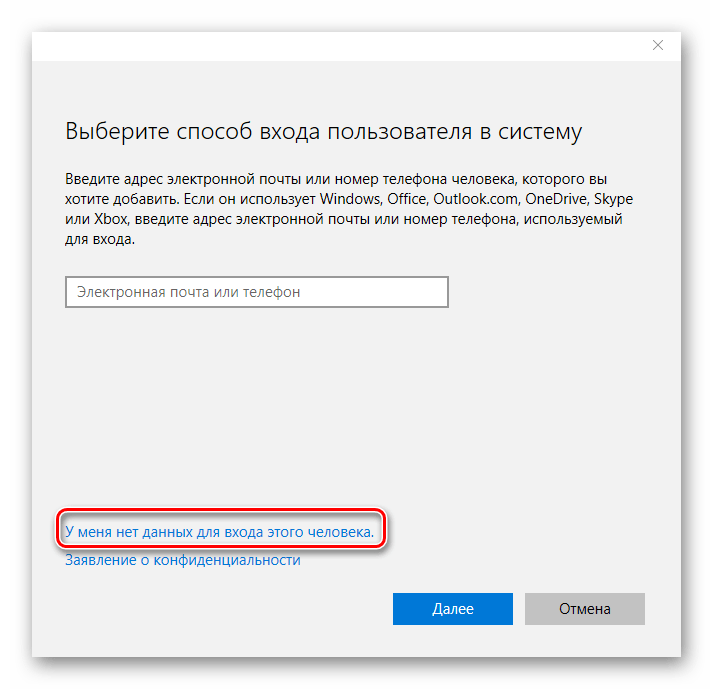
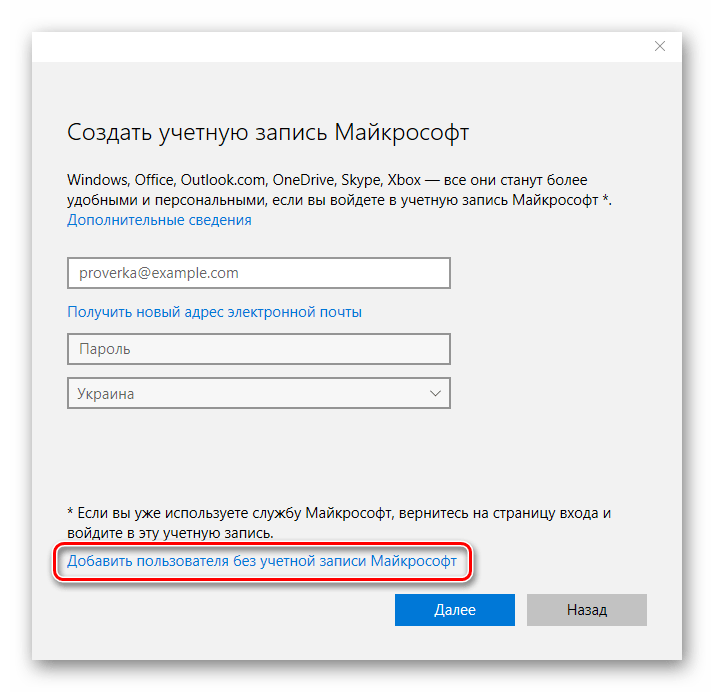
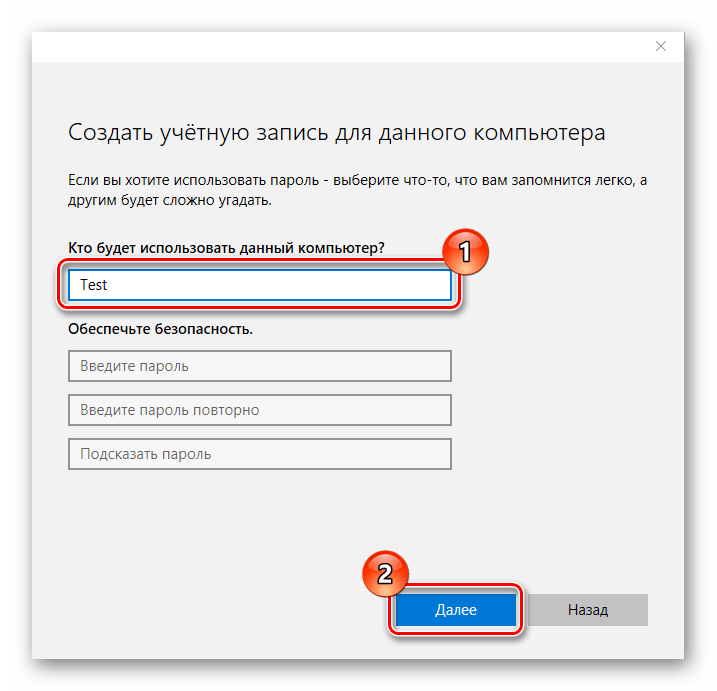
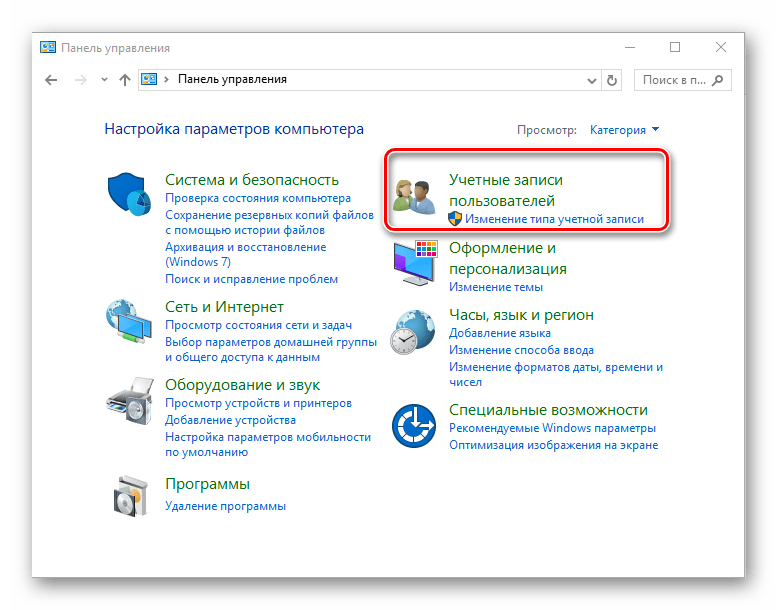
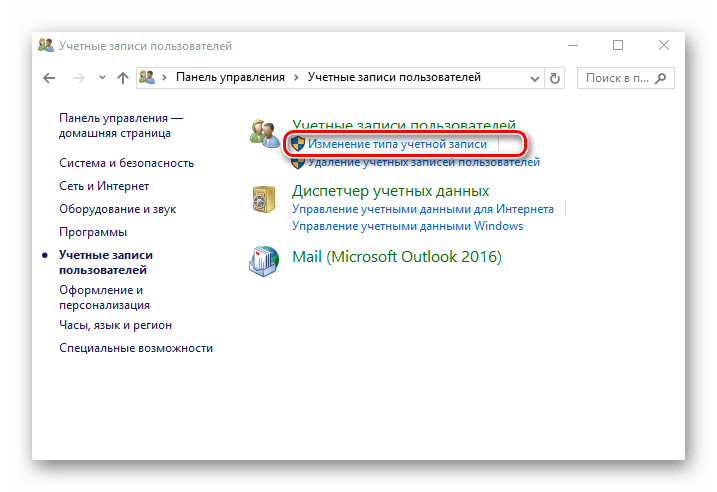
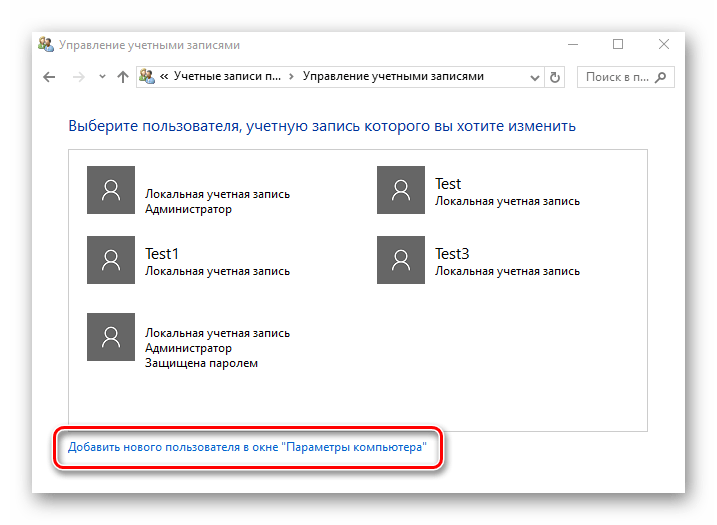

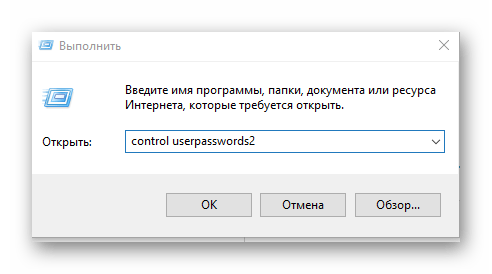
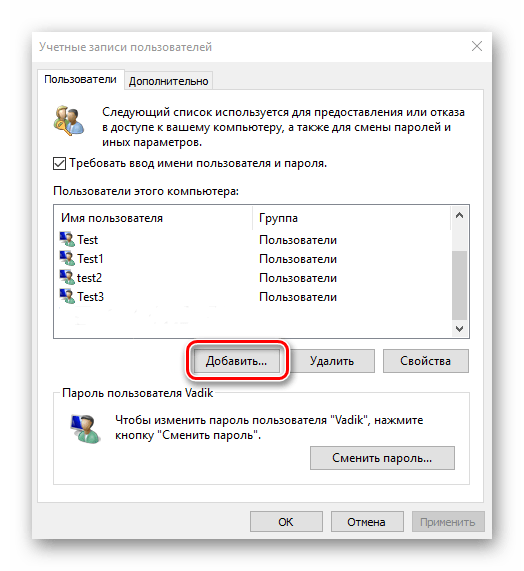
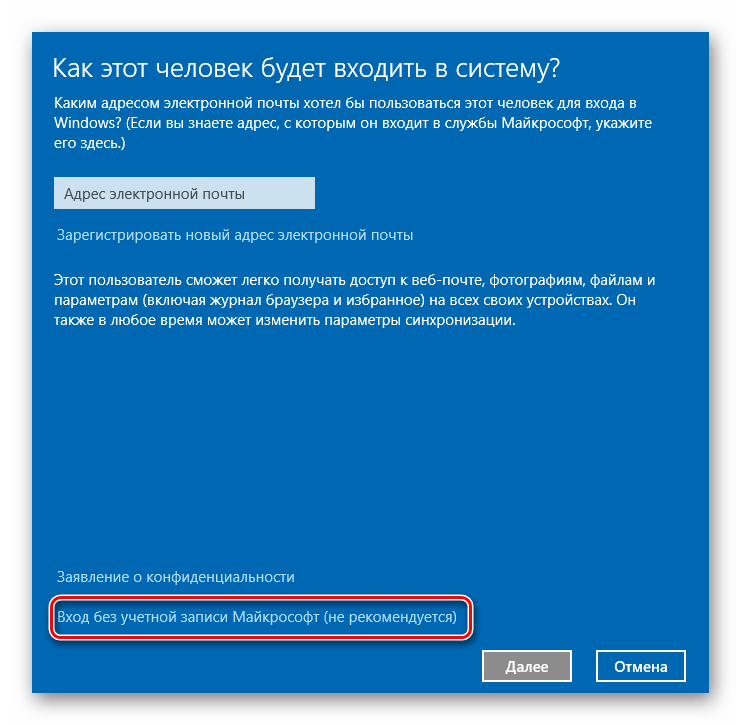
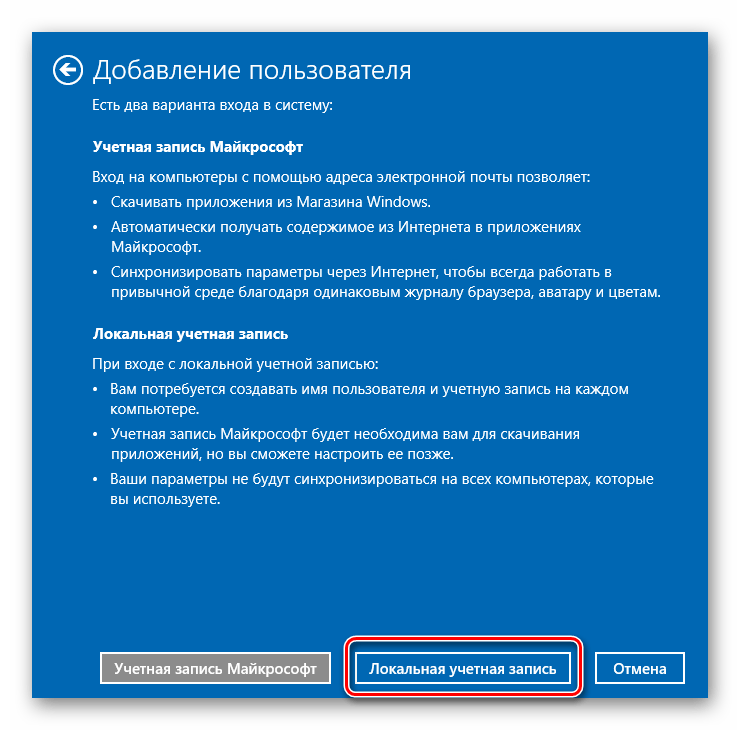
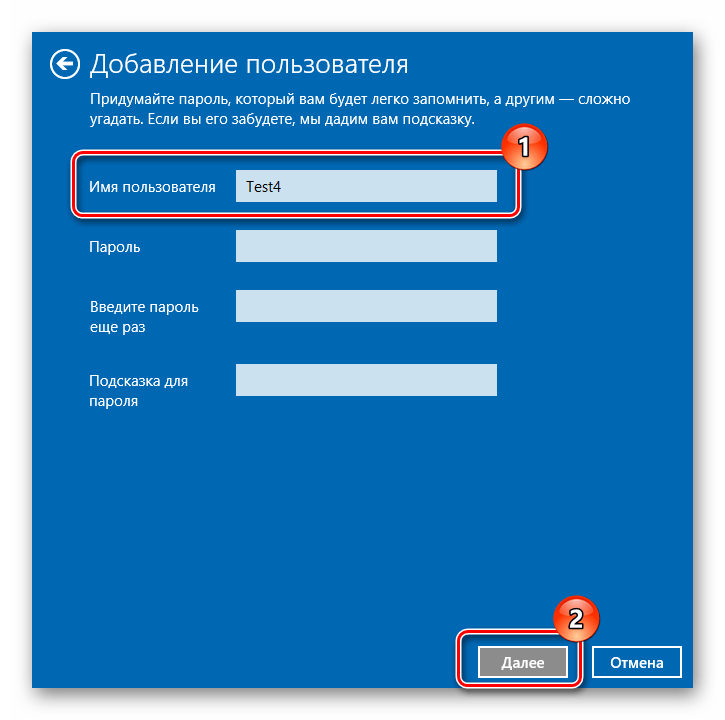
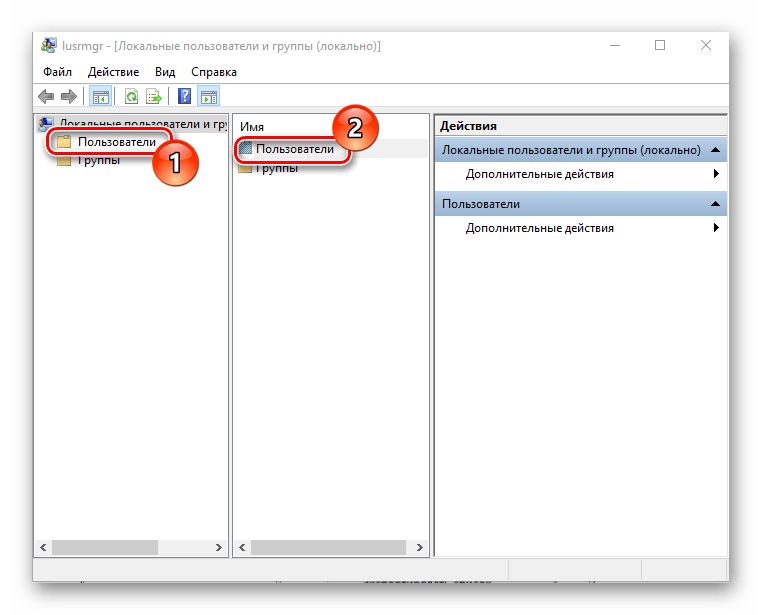








![image_thumb_thumb[1]](https://www.repairwin.com/wp-content/uploads/2019/01/image_thumb_thumb1_thumb.png)






![image_thumb[16]](https://www.repairwin.com/wp-content/uploads/2019/01/image_thumb16_thumb.png)
![image_thumb[19]](https://www.repairwin.com/wp-content/uploads/2019/01/image_thumb19_thumb.png)
